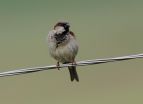(Press-News.org) For decades, maple syrup producers have eyed the weather to help understand spring sugar yields. But new research in the journal Forest Ecology and Management reveals a more valuable metric for understanding – and even predicting – syrup production: how many seed helicopters rained down from the trees the year before?
"Weather affects how much sap will flow out of the tree, but sap volume is only one piece of the puzzle," says Josh Rapp, who as a postdoctoral fellow with Elizabeth Crone, associate professor of biology at Tufts University and senior author on the paper, analyzed the factors influencing 17 years of maple syrup production at 28 sites in Vermont.
What really matters to maple syrup producers, Rapp explains, is the amount of sugar in the sap: "Sugar maple sap is 2 to 3 percent sugar. The rest is just water to boil off. Sweeter sap is more profitable. If you start with sap that's 3 percent sugar, it takes a third less sap to make a gallon of syrup."
So, what predicts how much sugar is in the sap? "Not weather," says Rapp. "Weather alone was a surprisingly bad predictor of how much sugar came out of the taps over those 17 years," says Rapp. "That tells us there is something else at play."
For several years, Rapp and Crone have been studying "mast" seeding events—years when trees collectively produce far more seeds than usual—at the Harvard Forest in Massachusetts. In sugar maples, mast seeding tends to occur every 2 to 5 years.
Recent mast seeding events occurred in Vermont in 2000, 2006, and 2011. Rapp's research shows that in Vermont, syrup production declined following every mast seed year.
"Both seeds and sugar are made from carbohydrates stored in trees," explains Crone. "When a tree produces a lot of seeds one summer, then the next spring, the carbohydrate bank account is low for making sugar. It's a matter of budgeting resources."
Looking ahead to next year's harvest, Rapp notes: "At the Harvard Forest, and likely throughout the northeast, the seed crop was small this year, suggesting the 2015 maple syrup harvest should be a good one."
Rapp explains weather's role in these predictions: "The best way to predict syrup production is actually a combination of factors: proportion of trees with seeds, minimum and maximum March temperatures, and maximum April temperature. Those factors together explained 79% of the variation in syrup production in Vermont from 1998 to 2014."
Because seeds develop a full six months before syrup harvest, Rapp hopes this study can help syrup producers plan ahead. "Maple syrup is a complicated natural resource," he says. "Hopefully this research can give producers a window into the upcoming season."
"The idea of looking at the costs of seed production came from very abstract models developed by mathematicians in Japan," adds Crone. "One of the purposes of academic science is to come up with general insights that help us see applied problems in new ways. This is a good example of that kind of insight."
INFORMATION:
The Harvard Forest, founded in 1907 and located in Petersham, Mass., is Harvard University's outdoor laboratory and classroom for ecology and conservation, and a Long-Term Ecological Research (LTER) site funded by the National Science Foundation. Its 3,700 acre property is one of the oldest and most intensively studied research forests in the U.S. Open to the public year-round, the site includes educational and research facilities, a museum, and recreational trails. More information can be found at http://harvardforest.fas.harvard.edu/.
Photos and the complete scientific paper are available at http://harvardforest.fas.harvard.edu/press-resources-sugar-maple-masting-story-113.
For an interview with one or more of the scientists, contact Clarisse Hart, Harvard Forest Outreach Manager.
Citation: JRapp and ECrone. 2014. Maple syrup production declines following masting. Forest Ecology and Management 335(1): 249-254. Available online 27 October 2014. DOI 10.1016/j.foreco.2014.09.041.
Karyotype is usually a stable feature of each species since chromosomal changes, if they occur, may contribute to the formation of barriers between populations causing the establishment of reproductive isolation and speciation as possible consequences. Indeed, mating between individuals with different karyotypes frequently produces hybrids with a reduced fertility (or sterile) due to mis-segregation of chromosomes during meiosis.
Despite the occurrence of this general rule, it seems that some animal species failed their examination in genetics and adopt different rules. ...
MADISON, Wis. – Scientists today disclosed a new method to convert lignin, a biomass waste product, into simple chemicals. The innovation is an important step toward replacing petroleum-based fuels and chemicals with biorenewable materials, says Shannon Stahl, an expert in "green chemistry" at the University of Wisconsin-Madison.
Lignin is the substance that makes trees and cornstalks sturdy, and it accounts for nearly 30 percent of the organic carbon in the biosphere. Stahl, senior author of a new report in the journal Nature, notes that lignin is a waste product ...
Scientists at the European Molecular Biology Laboratory (EMBL) in Heidelberg, Germany and collaborators from Heidelberg University, in the joint Molecular Medicine Partnership Unit, have obtained the first structure of the immature form of HIV at a high enough resolution to pinpoint exactly where each building block sits in the virus. The study, published online today in Nature, reveals that the building blocks of the immature form of HIV are arranged in a surprising way.
"The structure is definitely different from what we'd expected," says John Briggs from EMBL, who led ...
A new policy paper led by University of York scientists, in partnership with Proforest, aims to increase awareness among researchers of the High Conservation Value (HCV) approach to safeguarding ecosystems and species.
The HCV approach is widely used in sustainable land management schemes to identify important ecosystems and species to conserve, but is little known in academia and the scientific evidence base is lacking.
The policy paper encourages new research into the effectiveness of the HCV process and greater knowledge exchange between scientists, HCV users and ...
If chronic lymphocytic leukemia patients with a good or poor prognosis could be identified already at the time of diagnosis, physicians would have better possibilities to adjust their therapeutic and follow-up strategies. Now researchers at Uppsala University, together with international colleagues, have discovered a new correlation between specific molecular features of the disease and subgroups of patients with different prognosis.
The results have been published in the journal Lancet Haematology.
Chronic lymphocytic leukemia (CLL) is an incurable tumour disease ...
Some MRSA bugs in UK hospitals can be traced back to a type of bacteria found in farm animals, a study suggests.
A strain of drug-resistant bacteria carried by some livestock – the MRSA strain Staphylococcus aureus CC398 – has also been found in patients, researchers say.
People and animals generally harbour distinct variants of CC398, which the team say evolved from the same original bacteria. However, the CC398 strain found in livestock can be transmitted to humans, and the study shows that this has happened on many occasions.
The study provides new ...
Using the Very Large Telescope Interferometer (VLTI) in near-infrared light [1], the team of astronomers observed 92 nearby stars to probe exozodiacal light from hot dust close to their habitable zones and combined the new data with earlier observations [2]. Bright exozodiacal light, created by the glowing grains of hot exozodiacal dust, or the reflection of starlight off these grains, was observed around nine of the targeted stars.
From dark clear sites on Earth, zodiacal light looks like a faint diffuse white glow seen in the night sky after the end of twilight, or ...
Researchers from Australia report that low birth weight and preterm birth are linked to increased risk for osteoarthritis (OA)-related hip replacements in adulthood. Findings published in the American College of Rheumatology (ACR) journal, Arthritis Care & Research, indicate that low birth weight and pre-term babies were not at greater risk of knee arthroplasty due to OA as adults.
According to the ACR, 27 million Americans over the age of 25 are diagnosed with clinical OA. Symptoms of OA range from mild to severe and include pain, stiffness, and swelling of joints. ...
WHITE PLAINS, N.Y., Nov. 3, 2014 – The March of Dimes is calling for a nationwide effort to reduce U.S. preterm births to 5.5 percent of all live births by 2030. Seven other developed countries already have preterm birth rates below 6 percent, and 15 have rates below 7 percent.
The U.S. rate of 11.4 percent in 2013 is one of the highest. The U.S. ranked 37th out of 39 high resource countries in 2010.
"The United States spends more money per capita on health care than almost any other country in the world, and yet our premature birth rate and our infant mortality ...
Bird populations across Europe have experienced sharp declines over the past 30 years, with the majority of losses from the most common species, say the University of Exeter, the RSPB and the Pan-European Common Bird Monitoring Scheme (PECBMS) in a new study. However numbers of some less common birds have risen.
The study, published today in the journal Ecology Letters, reveals a decrease of 421 million individual birds over 30 years. Around 90 percent of these losses were from the 36 most common and widespread species, including house sparrows, skylarks, grey partridges ...



